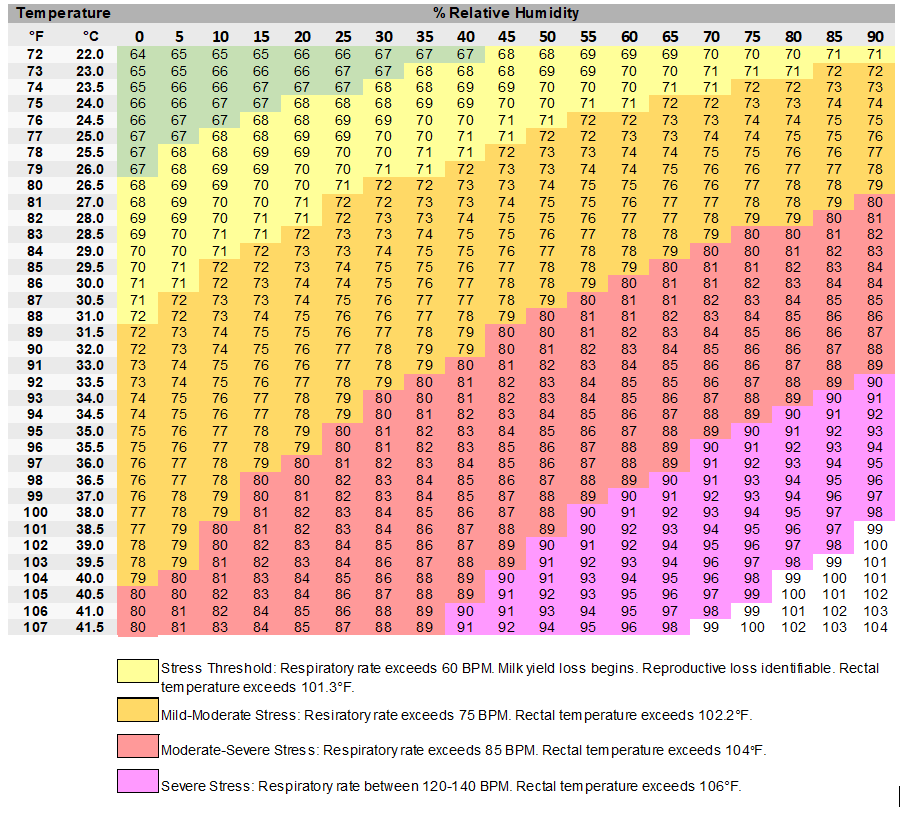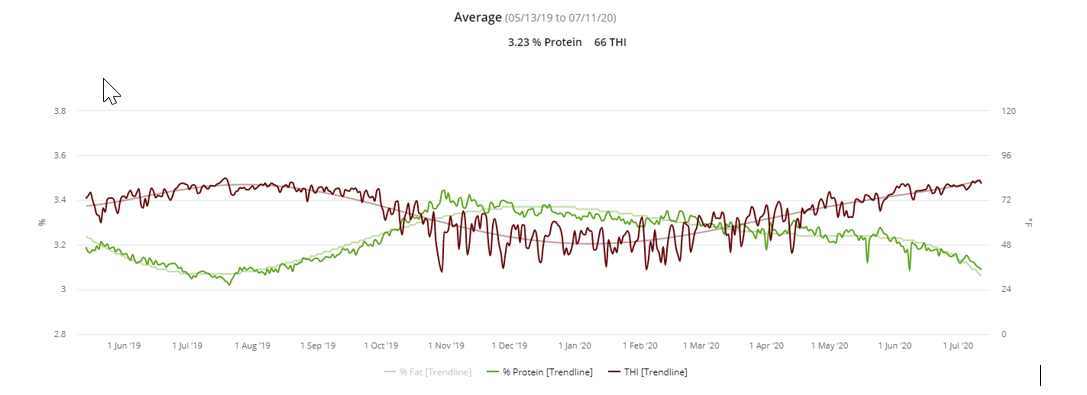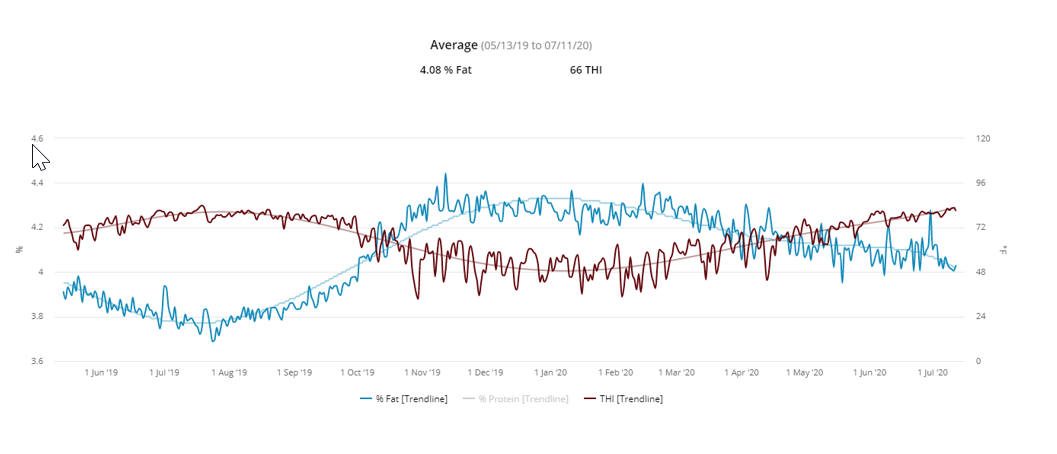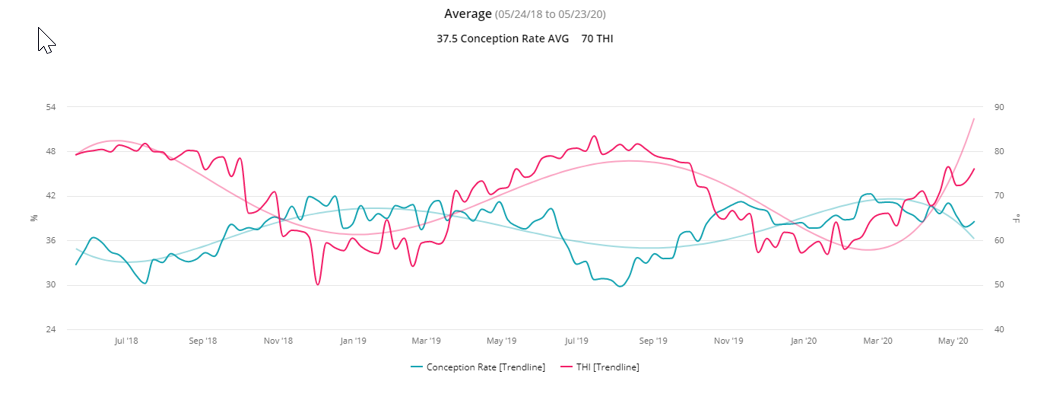Temperature Humidity Index (THI) is a measure that accounts for combined effects of environmental temperature and relative humidity, making it a useful tool to evaluate heat stress risk. While it is not all-encompassing, it does provide a fairly simple tool that producers can utilize to understand animal stress levels. Heat stress occurs when the core body temperature of an animal is greater than the range specified for normal activity. This occurs because the heat load from both internal heat and the environment exceed the animal’s capacity to dissipate heat, thus causing the animal to shift physiological response to try and compensate (Bernabucci et al., 2010). The upper limit of the thermoneutral zone for lactating dairy cows is between 70-80°F, and above this limit the animal starts to adjust body function to keep their core body temperature stable (Harner et al., 2009). When temperatures exceeds this limit, cows reduce their intake, sweat and pant, increasing feed needs for maintenance by 35% and reducing milk production, in some cases by up to 50%. Likewise, heat stress can impact reproduction, by reducing libido, fertility and embryonic survival in dairy cattle (Harner et al., 2009).
When humidity is taken into consideration, the THI scale can be applied. Zimbelman and Collier, 2009 updated original THI stress thresholds to better account for higher production animals. While the previous threshold was a THI of 72, the newer data suggest that the threshold should be lowered to 68 THI. Above 68 THI, animals start to exhibit increased respiration, increased rectal temperatures, and reductions in production and reproduction.
Figure 1. Revised Temperature Humidity Index for Lactating Dairy Cows (Adapted from Zimbelman and Collier, 2009)
For producers, understanding the implications of heat stress on cattle performance and reproduction is key. Once a producer knows the seasonal trends that are typical for their herd, it helps them set a baseline and either try to move that baseline up, troubleshoot when something may be causing the herd to perform below baseline, and provide a frame of reference should a producer make an investment to try and mitigate the effects of heat stress. Branded Feed has started utilizing the new OneTrak Dashboard (www.smarteronetrak.com) information to help individual producers get a better handle on some of these parameters, as well as better understanding of seasonal trends for a large group of lactating animals (~84K head). The following three graphs illustrate some of the seasonal trends that consistently occur in dairy production systems. It is clear that components, and reproduction consistently bottom out when THI is peaking.
While it is unlikely producers will be able to fully erase impacts of THI, there are things that can help mitigate the issue. Individual locations will have varying needs depending on their facility design. However, items like fans that increase air flow in pens and in the milk parlor, sun shades that provide animals a place to get out of direct sunlight, or increased ventilation in free-stall or cross ventilated barns are all options that can help reduce THI stress. Our goal within Branded Feed is to provide producers with cutting-edge tools to better manage their herds, and in turn, be more successful long-term.
Figure 2: % Protein versus THI (14 months starting May 2019)
Figure 3: % Fat versus THI (14 months starting May 2019)
Figure 4: Conception Rate versus THI (24 May 2018 through May 2020)
References:
Bernabucci, U., N. Lacetera, L.H. Baumgard, R.P. Rhoads, B. Ronchi, and A. Nardone. 201. Metabolic and hormonal acclimation to heat stress in domesticated ruminants. The Animal Consortium. 4:7, 1167-1183.
Harner, J. P., J. F. Smith, B. J. Bradford, M. Overton, and K. C. Dhuyvetter. 2009. In the thermoneutral zone: Potential benefits of lpcv buildings. Western Dairy Management Conference.
Zimbelman, R. and R.J. Collier. 2011. Feeding Strategies for high-producing dairy cows during periods of elevated heat and humidity. Tri-State Dairy Nutrition Conference. April 19 and 20.
Cargill Branded Feed creates proprietary feed ingredients to improve digestive health and performance for production animals in the beef, dairy, aquaculture and pet food markets. Branded Feed is a segment of Cargill Starches, Sweeteners & Texturizers (CSST).


 Download as pdf
Download as pdf




